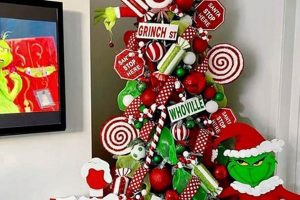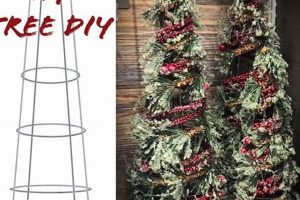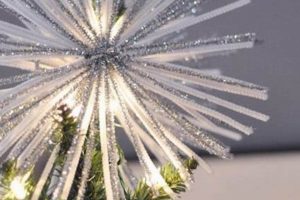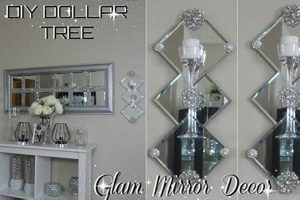The construction of miniature winter scenes encased in glass, utilizing materials sourced from discount retailers, represents a cost-effective and accessible crafting activity. These decorative items, often created using readily available glass containers, figurines, and glitter, offer an opportunity for personalized seasonal ornamentation.
The popularity of this project stems from its affordability and potential for creative expression. It allows individuals to produce unique decorations suitable for gifting or personal display, avoiding the expense of purchasing commercially manufactured alternatives. The use of widely accessible materials also promotes resourcefulness and encourages hands-on creation. Historically, snow globes have served as symbols of nostalgia and winter wonder, and the “do-it-yourself” version allows individuals to connect with this tradition in a tangible way.
The following sections will detail specific materials, construction methods, and design considerations for crafting these personalized winter decorations. Focus will be given to maximizing aesthetic appeal while minimizing material costs, drawing upon resources available at budget-friendly retail locations.
Tips for Constructing Economical Winter Scenes
The following provides practical advice for crafting miniature winter scenes, emphasizing budget-conscious material selection and construction techniques. Attention to detail during assembly enhances the aesthetic appeal and longevity of the finished product.
Tip 1: Container Selection: Opt for glass jars with smooth, unobstructed interiors. Clean thoroughly and ensure a watertight seal with the base. Avoid containers with irregular shapes that may distort the interior view.
Tip 2: Figurine Securing: Employ waterproof adhesive suitable for bonding plastic or ceramic to glass. Allow ample drying time as directed by the adhesive manufacturer to prevent detachment during use.
Tip 3: Simulated Snow Application: Utilize fine-grain glitter or artificial snow to create a realistic snowfall effect. Avoid excessive amounts, as clumping can occur. Consider layering different textures for visual depth.
Tip 4: Water Quality Control: Distilled water is recommended to minimize clouding and mineral deposits. A small amount of glycerin can be added to slow the descent of the simulated snow.
Tip 5: Base Construction: A stable base is crucial for preventing tipping. Utilize weighted materials or a wide, flat surface to ensure stability. Decorative elements can be added to enhance the visual appeal of the base.
Tip 6: Sealing Integrity: Thoroughly inspect the seal between the container and the base to ensure water tightness. Apply additional sealant if necessary and allow ample drying time before filling with water.
Tip 7: Material Compatibility: Test all materials in water before final assembly to ensure they do not leach color or degrade over time. This prevents discoloration of the water and maintains the clarity of the scene.
Adhering to these guidelines ensures the creation of aesthetically pleasing and durable miniature winter scenes, maximizing the use of affordable materials and promoting a long-lasting decorative item.
The subsequent section will address common challenges encountered during construction and provide solutions for troubleshooting potential issues.
1. Affordable materials
The concept of constructing miniature winter scenes is intrinsically linked to the availability of budget-friendly components. Without access to economical materials, the feasibility of widespread engagement with this activity diminishes significantly. The “diy snow globe dollar tree” approach leverages the accessibility of inexpensive resources to democratize a craft traditionally associated with more costly commercially manufactured items. The selection of materials becomes a pivotal factor, influencing both the final aesthetic outcome and the overall economic viability of the project. For example, choosing inexpensive glass jars, readily available at dollar stores, instead of specialized crafting containers, directly reduces production expenses. Similarly, utilizing bulk glitter or artificial snow substitutes from the same source maintains a low cost per unit, enabling production on a larger scale or allowing for repeated attempts without significant financial burden. This access facilitates experimentation and personalization, encouraging broader participation among individuals with limited resources.
The reliance on affordable materials directly impacts the creative process, encouraging resourcefulness and innovation. Constraints imposed by budget limitations often lead to novel approaches in design and construction. For instance, repurposing existing household items as decorative elements, such as using bottle caps or small toys, transforms potential waste into integral components of the miniature scene. This not only reduces material costs but also promotes sustainable practices and fosters a deeper connection with the crafted object. The inherent challenge of working with inexpensive materials necessitates a higher degree of skill and attention to detail in the construction phase. Ensuring the structural integrity of the scene, achieving a watertight seal, and maximizing the visual appeal despite material limitations all require a refined understanding of the craft and the properties of the selected components.
In summary, the connection between affordable materials and the “diy snow globe dollar tree” concept is one of symbiotic dependence. The availability of inexpensive resources forms the foundation upon which this craft is built, enabling widespread accessibility and promoting resourcefulness in design and construction. While challenges associated with material limitations exist, they simultaneously encourage creativity and skill development. Ultimately, the success of this crafting activity relies on a balance between economic feasibility and aesthetic appeal, achieved through the strategic selection and utilization of budget-friendly components. The democratization of craft through affordable materials allows a broader audience to engage with the creation process.
2. Creative personalization
The inherent value of the “diy snow globe dollar tree” activity lies in its capacity for creative personalization. Mass-produced decorative items offer limited scope for individual expression; however, the “do-it-yourself” approach empowers individuals to imbue these winter scenes with personal meaning and unique aesthetic qualities. This personalization is not merely a superficial customization but rather a core element that elevates the activity beyond simple replication of a commercial product. The choice of figurines, the arrangement of the scene, and the selection of snow substitutes all contribute to a bespoke creation reflecting the maker’s individual taste and preferences. For instance, instead of using generic winter-themed figurines, a creator may opt to incorporate miniature representations of personal interests, such as pets, hobbies, or favorite characters. The effect transforms the item from a mere decoration into a tangible expression of individuality.
The opportunity for personalization extends to the choice of container and the creation of the base. Standard glass jars can be modified with paint, ribbon, or other decorative elements to enhance their aesthetic appeal and integrate them seamlessly into the overall design. Similarly, the base can be customized with personalized messages, dates, or thematic elements to commemorate special occasions or to create unique gifts. The practical application of this understanding is evident in the rising popularity of “diy snow globe dollar tree” kits that provide a basic framework but encourage individuals to source their own materials and design their own unique scenes. This approach recognizes the inherent value of creative expression and empowers individuals to craft decorations that resonate with their personal values and experiences. Furthermore, this personalization can foster emotional connections to the object, as they become imbued with personal meaning and memories.
In conclusion, the connection between creative personalization and the “diy snow globe dollar tree” activity is fundamental to its appeal and value. This element transcends the mere creation of a decorative object, enabling individuals to express their unique personalities, commemorate special occasions, and foster emotional connections through tangible creations. The recognition and promotion of this personalized element are crucial for sustaining the popularity and enriching the experience of crafting these miniature winter scenes. The act of creation becomes a form of self-expression and personal storytelling, using inexpensive materials to forge lasting memories.
3. Seasonal decoration
The creation of miniature winter scenes directly aligns with the tradition of seasonal decoration, representing a tangible expression of festive spirit and a visual marker of the winter holidays. The practice of adorning homes and spaces with thematic objects is deeply embedded in cultural practices worldwide, and the “diy snow globe dollar tree” activity offers an accessible means of participation in this tradition.
- Cost-Effective Festive Expression
The use of discount retailer materials allows for participation in seasonal decorating without substantial financial investment. This accessibility democratizes the tradition, enabling individuals and families with limited resources to create personalized decorations that reflect the spirit of the season. These are typically displayed on shelves, mantels, or tables, contributing to the overall ambiance of a festive environment.
- Thematic Customization
Seasonal decorating often revolves around specific themes or motifs associated with the winter holidays. The “diy snow globe dollar tree” project allows for the incorporation of these themes through the selection of figurines, snow substitutes, and decorative elements. A common theme is a winter wonderland and can be tailored to specific holiday traditions or personal preferences.
- Tradition and Nostalgia
The snow globe itself carries inherent nostalgic associations with childhood and winter holidays. Creating personalized versions can evoke memories and strengthen familial bonds. The tradition of creating and displaying these items year after year can establish new family traditions and reinforce a sense of continuity and connection to the past. This is especially true when incorporating found objects from previous years’ festivities.
- Engagement and Activity
Beyond the final product, the creation of a “diy snow globe dollar tree” can serve as a valuable activity for families or individuals during the holiday season. It provides an opportunity for shared creativity, collaboration, and quality time spent together. The process of selecting materials, designing the scene, and assembling the globe fosters a sense of accomplishment and shared ownership of the decoration. This encourages active participation in the holiday festivities, rather than passive consumption of commercially produced decorations.
The act of crafting miniature winter scenes serves as a tangible connection to the larger tradition of seasonal decoration. These decorations contribute to the overall ambiance of the festive period, reinforcing cultural values and creating shared experiences. The cost-effectiveness and creative potential of the “diy snow globe dollar tree” project enhance its accessibility and broaden its appeal, allowing a wider range of individuals and families to actively participate in the winter holiday season. The personalized aspect strengthens emotional connections to the objects, making them more than just decorations, but symbols of cherished memories and traditions.
4. Waterproof sealing
Waterproof sealing is a critical factor in the successful creation and longevity of a miniature winter scene constructed with budget-conscious materials. The integrity of the seal directly impacts the functionality and aesthetic appeal of the finished product, preventing leaks and maintaining the clarity of the internal environment. Without effective waterproof sealing, the project becomes unsustainable, leading to potential damage and aesthetic degradation.
- Adhesive Selection and Application
The choice of adhesive is paramount for establishing a durable waterproof seal. The adhesive must exhibit strong bonding properties with both glass and the chosen base material (e.g., plastic, wood, ceramic). Application technique is equally crucial. Surfaces must be clean and dry to ensure proper adhesion. A consistent bead of adhesive, applied evenly around the perimeter of the jar’s opening, is necessary to prevent gaps that could compromise the seal. Furthermore, adequate curing time, as specified by the adhesive manufacturer, must be observed before introducing water to the scene.
- Jar and Base Compatibility
The compatibility of the glass jar and the base material significantly impacts the ease and effectiveness of creating a waterproof seal. Smooth, even surfaces provide a better bonding surface for the adhesive. Irregularities or imperfections in either the jar or the base can create points of weakness in the seal, increasing the risk of leaks. Careful selection of materials and thorough inspection for surface flaws are essential preventative measures.
- Environmental Factors and Material Degradation
Environmental factors, such as temperature fluctuations and humidity, can contribute to the degradation of the waterproof seal over time. Extreme temperature changes can cause expansion and contraction of the materials, potentially weakening the adhesive bond. Prolonged exposure to moisture can also compromise the integrity of certain adhesives. Selecting adhesives specifically formulated for resistance to water and temperature variations is crucial for long-term durability. In addition, selecting figurines and decorative elements that are impervious to water is also an important consideration.
- Testing and Remediation
Thorough testing of the seal is a necessary step before completing the project. After the adhesive has fully cured, the assembled globe should be filled with water and carefully inspected for any signs of leakage. If leaks are detected, the affected areas should be thoroughly dried, and additional adhesive should be applied to reinforce the seal. Multiple testing cycles may be required to ensure a completely waterproof enclosure. This proactive approach minimizes the risk of future problems and ensures the longevity of the miniature winter scene.
The implementation of effective waterproof sealing techniques is essential for the successful realization of the “diy snow globe dollar tree” project. The careful selection of appropriate materials, proper application techniques, and thorough testing procedures contribute to the creation of a durable and aesthetically pleasing decorative item. By prioritizing this aspect of the construction process, creators can ensure the long-term enjoyment and visual integrity of their miniature winter scenes. The seal serves as a barrier protecting the delicate scene and therefore enhances its value.
5. Stable base
The “diy snow globe dollar tree” project necessitates a stable base as a foundational element for both functional integrity and aesthetic presentation. The base provides the structural support required to prevent the globe from tipping, minimizing the risk of damage to the enclosed miniature scene and preventing potential spills. A stable base also elevates the visual appeal by offering a platform for decorative embellishments and enhancing the overall presentation of the completed item. The absence of a stable base compromises the functionality and diminishes the aesthetic value, thereby detracting from the overall success of the project. An unstable snow globe poses a safety hazard, especially when handled by children.
The selection of materials and the design of the base are crucial considerations in achieving stability. A wide, flat base constructed from a relatively heavy material, such as wood or a weighted plastic, provides a low center of gravity, reducing the likelihood of tipping. Adhering the glass jar securely to the base using a robust adhesive is also essential. Examples of stable base designs include circular wooden platforms, repurposed candle holders, or even weighted resin castings. Conversely, a narrow or lightweight base is prone to instability, especially when the globe is filled with water and decorative elements. Therefore, careful planning and material selection are paramount. Testing the stability of the base before completing the scene is important to prevent potential instability later.
In summary, the stable base is an indispensable component of the “diy snow globe dollar tree” project. Its primary function is to ensure the safety and stability of the globe, preventing accidents and protecting the enclosed miniature scene. Furthermore, the base contributes significantly to the aesthetic presentation, providing a platform for decorative enhancements and elevating the overall visual appeal. The careful selection of materials, thoughtful design considerations, and robust construction techniques are all essential for achieving a stable base and maximizing the success of the project. The overall experience is therefore dependent on the execution of a functional and aesthetically suitable base.
6. Clear water
The clarity of the water within a self-constructed miniature winter scene is a paramount factor in determining the aesthetic quality and visual appeal of the finished product. The choice of fluid directly impacts the observer’s ability to appreciate the intricate details and overall composition of the enclosed scene. Compromised water clarity detracts from the visual experience, obscuring the miniature landscape and diminishing the value of the crafting effort.
- Source Water Selection
The type of water used significantly influences clarity. Tap water typically contains minerals and impurities that can cause clouding or discoloration over time. Distilled water, devoid of these additives, provides a superior alternative, minimizing the risk of undesirable visual artifacts. While other options exist, distilled water is usually the most economical and accessible for “diy snow globe dollar tree” projects.
- Particulate Suspension Management
The inclusion of artificial snow or glitter inevitably introduces particulate matter into the water. To mitigate the impact on clarity, selecting fine-grade materials is advisable. Larger particles tend to settle more quickly, creating localized concentrations and obscuring the scene. Furthermore, pre-washing glitter or artificial snow can remove excess residue and minimize clouding. Additionally, a very small amount of glycerin is sometimes added to the water to slow the descent of the particles and give them a more realistic “snowfall” effect.
- Material Compatibility Considerations
The materials used within the miniature scene must be chemically inert to prevent leaching of dyes or other substances into the water. Certain plastics, paints, or adhesives may react with water, resulting in discoloration or clouding. Thoroughly testing materials in water prior to assembly is crucial to ensure compatibility and maintain water clarity over time. This often means soaking a small test piece for a period of time before including it in the final project.
- Preventative Measures and Maintenance
Even with careful material selection and preparation, maintaining water clarity over extended periods may require preventative measures. Adding a small amount of algaecide can inhibit the growth of microorganisms that can cloud the water. Periodically agitating the globe can also help prevent settling of particulate matter and maintain a more uniform distribution of the simulated snow. Furthermore, storing the globe in a location with minimal exposure to direct sunlight can reduce the risk of algae growth.
In the context of the “diy snow globe dollar tree,” achieving and maintaining clear water is a practical and cost-effective objective. The use of readily available distilled water, combined with careful material selection and preventative maintenance, allows for the creation of visually appealing miniature winter scenes that retain their aesthetic value over time. These techniques contribute significantly to the overall success and enjoyment of the crafting project.
Frequently Asked Questions
The following addresses common inquiries regarding the creation of miniature winter scenes using resources primarily sourced from discount retailers. The information presented aims to provide clarity and guidance on various aspects of the construction process.
Question 1: Is it possible to create a visually appealing and durable snow globe using only materials from a dollar store?
The feasibility of producing a satisfactory snow globe with exclusively dollar store materials hinges on careful selection and meticulous execution. While the materials may be of lower quality than those found in dedicated craft stores, a visually acceptable and reasonably durable product is achievable with attention to detail.
Question 2: What type of adhesive is recommended for creating a waterproof seal between the jar and the base?
A waterproof adhesive formulated for use on both glass and the base material (typically plastic or ceramic) is essential. Epoxy resins or certain silicone-based sealants are often suitable choices. The adhesive instructions regarding surface preparation and curing time should be strictly adhered to for optimal bonding.
Question 3: What fluid is best for filling the snow globe, and what additives are recommended?
Distilled water is the recommended fluid, as it minimizes the risk of clouding caused by mineral deposits. The addition of a small amount of glycerin can slow the descent of the artificial snow, creating a more visually appealing effect.
Question 4: How can clouding of the water be prevented or minimized?
Clouding can be mitigated by using distilled water, thoroughly rinsing artificial snow or glitter before use, and ensuring that all materials within the globe are chemically inert and do not leach dyes or other substances into the water. Regular agitation can also help prevent the settling of particulate matter.
Question 5: What are the potential safety concerns associated with DIY snow globes, particularly when children are involved?
Potential safety hazards include the risk of glass breakage, ingestion of small parts (artificial snow, figurines), and exposure to potentially harmful adhesives. Adult supervision is crucial when children are involved in the crafting process. Non-toxic adhesives and shatter-resistant plastic containers are recommended when crafting with children.
Question 6: How can the stability of the snow globe be ensured to prevent tipping and potential spills?
A wide, flat base constructed from a relatively heavy material provides a low center of gravity and enhances stability. Securely adhering the glass jar to the base with a strong adhesive is also essential. Thoroughly testing the stability of the assembled globe before completing the project is highly recommended.
In summary, the successful creation of a miniature winter scene using materials from budget retailers requires careful attention to material selection, construction techniques, and safety precautions. Adhering to these guidelines will enhance the visual appeal, durability, and safety of the finished product.
The following section will explore advanced techniques for enhancing the aesthetic appeal and durability of such items.
Conclusion
The preceding exploration has detailed the construction of miniature winter scenes utilizing materials primarily sourced from discount retailers. Key considerations include material selection for both aesthetic appeal and chemical inertness, the implementation of effective waterproofing techniques to ensure structural integrity, and the design of a stable base to prevent accidental displacement. The selection of fluid and management of particulate matter are crucial factors in maintaining the clarity of the encapsulated environment. Furthermore, potential safety concerns, particularly when involving children in the construction process, warrant careful consideration and the implementation of appropriate precautionary measures.
The pursuit of economical and aesthetically pleasing decorative items remains a relevant endeavor. Continued refinement of construction techniques and exploration of readily available materials may further enhance the accessibility and sustainability of this crafting activity. The principles outlined herein provide a foundation for individuals seeking to create personalized and visually compelling miniature winter scenes while adhering to budgetary constraints. The success of this endeavor lies in a balance between economic feasibility, creative expression, and a commitment to safety and durability.







